This is one in a series of posts on the Fujifilm GFX 100S. You should be able to find all the posts about that camera in the Category List on the right sidebar, below the Articles widget. There’s a drop-down menu there that you can use to get to all the posts in this series; just look for “GFX 100S”. Since it’s more about the lenses than the camera, I’m also tagging it with the other Fuji GFX tags.
I’ve been posting a lot recently about the 120 mm f/4 GF macro lens for the GFX. I found it a good performer at 1:2, at minimum focusing distance (MFD) with no extension tubes, but that it had really soft edges and a lot of focus curvature at MFD with 36 mm of tubes. In this post, I tested it at 1:1 with a 45 mm tube,a and found it credible on-axis but soft on the right edge of the frame. I reported those results numerically and visually, using the time honored sharpness target of a banknote. The 120/4 GF was soft in the corners and edges at MFD with 18mm, 36mm, and 45mm of extension by tubes.
For copy applications at high magnifications, and for some 3D subjects that require extension tubes, the 120/4 GF just isn’t cutting it. I tried the CV 125/2.5 and it was a big improvement. I’d tried a Schneider 90 mm f/4.5 Apo Componon enlarging lens, and it was a disappointment at 1:1. I’d heard good things about the Pentax 645 120mm f/4 smc FA macro lens. It was almost as good as the CV 125/2.5 — and is substantially easier to find and less expensive.
My search for lenses that would do well on the GFX 100 at 1:1 led me to what are often called process lenses. The term originally referred to photographic reproduction processes, and now is used to identify lenses optimized for particular magnifications and designed for industrial use. Schneider Kreuznach makes a line of such lenses. One set in the line is 120mm in focal length, which is convenient for 1:3 to 1:1 reproduction. The name is Makro Symmar. The widest f-stop is either f/5.9 or f/5.6, depending on which version of the lens you get. There are four members of the line, and they are optimized for different reproduction ratios.
- The 0058/0158 is optimized for 1:1
- The 0059/0159 is optimized for 1:1.33
- The 0060/0160 is optimized for 1:2
- The 0061/0161 is optimized for 1:3
This test is of the 0058 version, and the lens is used at its designed reproduction ratio of 1:1.
The 120/5.6 Makro Symmars have an image circle of 85 mm (presumably at their optimum reproduction ratio). The GFX cameras have a diagonal of 55 mm, so that’s plenty of coverage.
There’s an issue: the lens mount is something called V38, which is a setscrew 38mm mount. You have to Macgyver the lens on to your camera. Here’s the setup I used for this test:
If you’re into this kind of thing, the lens is attached to a V38 to M42 converter, which is attached to a M42 to M65 converter, which is attached to a stack of M65 tubes, which is attached to an M65 helicoid, which is attached to an M65 to GFX converter. It all works pretty well, except that the 30 mm M65 tube closest to the camera has some reflections which cause flare in the final image. It’s not so bad that it keeps me from running some sharpness tests (though it probably degrades the results a bit), but I’ll have to fix it before actually using the lens. I’ve ordered some self-adhesive flocking paper from Edmund Optical. I’ll probably repeat this test when I get my camera setup all flocked up.
Here’s the test procedure:
- GFX 100S
- Foba camera stand
- C1 head
- Lens focused to get to 1:1 magnification
- ISO 100
- Electronic shutter
- Indicated f/5.6 through f/11 in whole-stop steps
- Exposure time adjusted in M mode
- Cognisys rail 100 exposures, 40 um step size
- Initial focus short of target
- Convert RAF to DNG using Adobe DNG Converter
- Extract raw mosaics with dcraw
- Extract slanted edge for each raw plane in a Matlab program the Jack Hogan originally wrote, and that I’ve been modifying for years.
- Analyze the slanted edges and produce MTF curves using MTF Mapper (great program; thanks, Frans)
- Fit curves to the MTF Mapper MTF50 values in Matlab
- Correct for systematic GFX focus bracketing inconsistencies
- Analyze and graph in Matlab
The results, compared to the Fuji 120/4 GF:
The vertical axis is MTF50 in cycles per picture height. Higher is sharper. The horizontal axis is f-stop.
- The blue and red columns are for the Schneider lens on axis, with, respectively, a horizontal and a vertical edge.
- The yellow and purple columns are for the Fuji 120/4 macro lens on axis, with, respectively, a horizontal and a vertical edge.
- The green and light blue columns are for the Schneider lens on the right side of the 33×44 mm frame, with, respectively, a horizontal and a vertical edge.
- The brick red and blue columns are for the Fuji 120/4 macro lens on the right side of the 33×44 mm frame, with, respectively, a horizontal and a vertical edge.
At its optimum aperture of f/5.6, the Makro Symmar is about as sharp in the center as the Fuji lens, and far sharper at the edge. In fact, it is virtually as sharp at the edge as in the center.
A word about the f-stops. I’ve plotted the indicated f-stops, not the effective ones. The Fuji lens used internal focusing, which means that the focal length gets shorter as you focus closer. That in turn means that the effective f-stop doesn’t narrow down as fast as it does with a lens like the Schneider Kreuznach that maintains its focal length as you focus closer. That explains the Fuji’s apparent better performance at the narrower f-stops.
Comparing the Schneider lens to the best 1:1 lens for the GFX I’ve found up to now:
- The blue and red columns are for the Schneider lens on axis, with, respectively, a horizontal and a vertical edge.
- The yellow and purple columns are for the CV lens on axis, with, respectively, a horizontal and a vertical edge.
- The green and light blue columns are for the Schneider lens on the right side of the 33×44 mm frame, with, respectively, a horizontal and a vertical edge.
- The brick red and blue columns are for the CV lens on the right side of the 33×44 mm frame, with, respectively, a horizontal and a vertical edge.
We have a new winner. The Schneider lens is much better off axis at the most usable f-stops.
Microcontrast, which I’m defining as contrast at 0.25 cycles per pixel, with the Fuji and the Schneider lenses:
Here are the MTF50 versus focal plane displacement curves for f/5.6 and f/8 with the Schneider lens on axis.
There is some longitudinal chromatic aberration (LoCA).
At the edge:
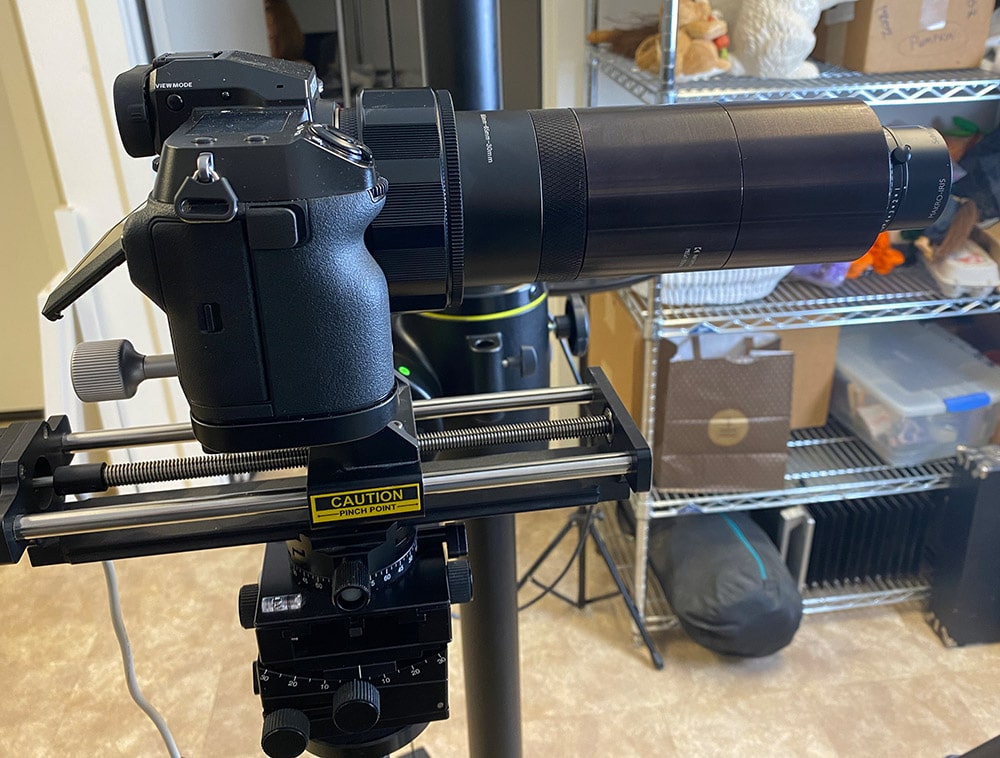
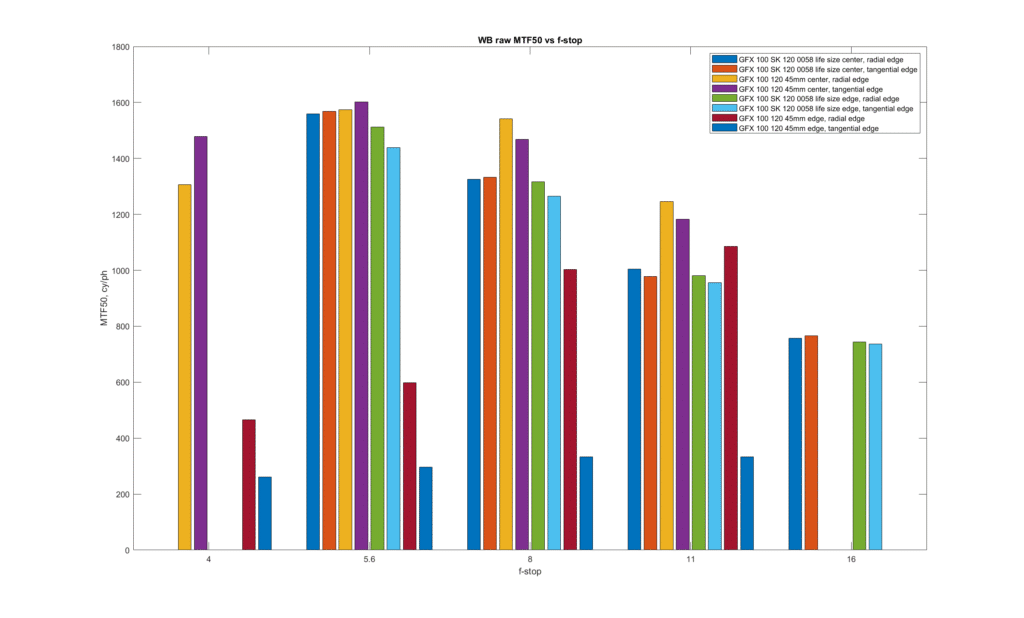
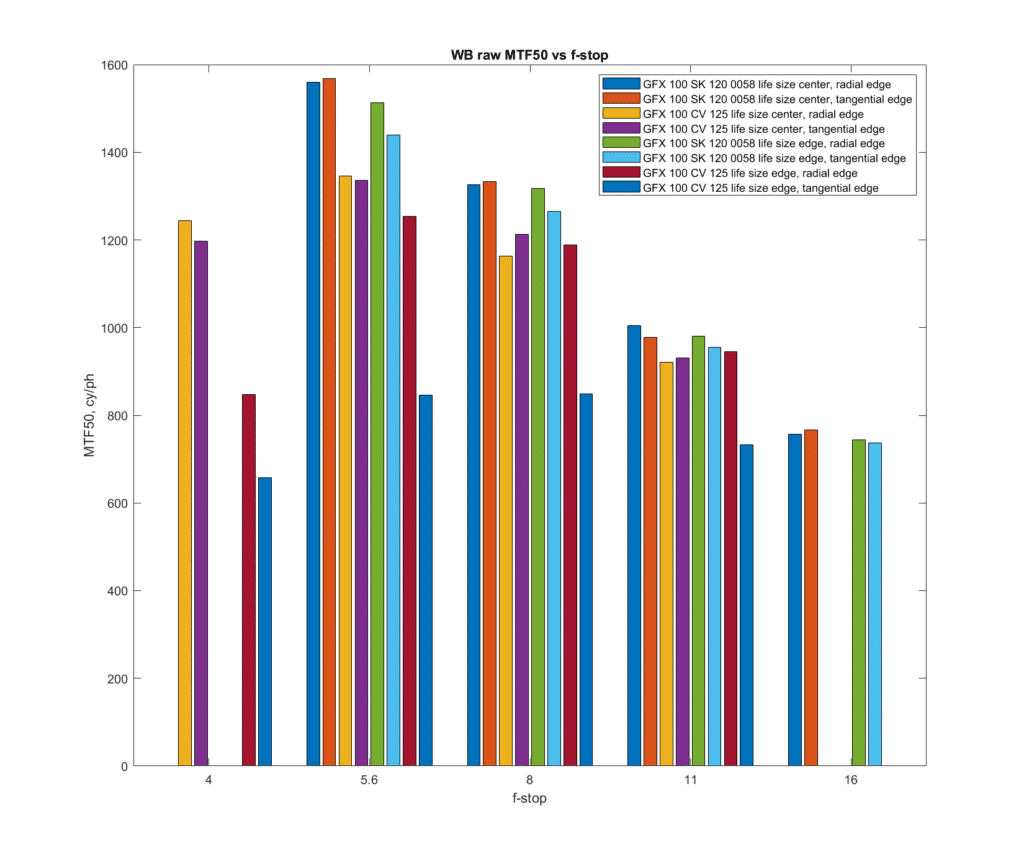
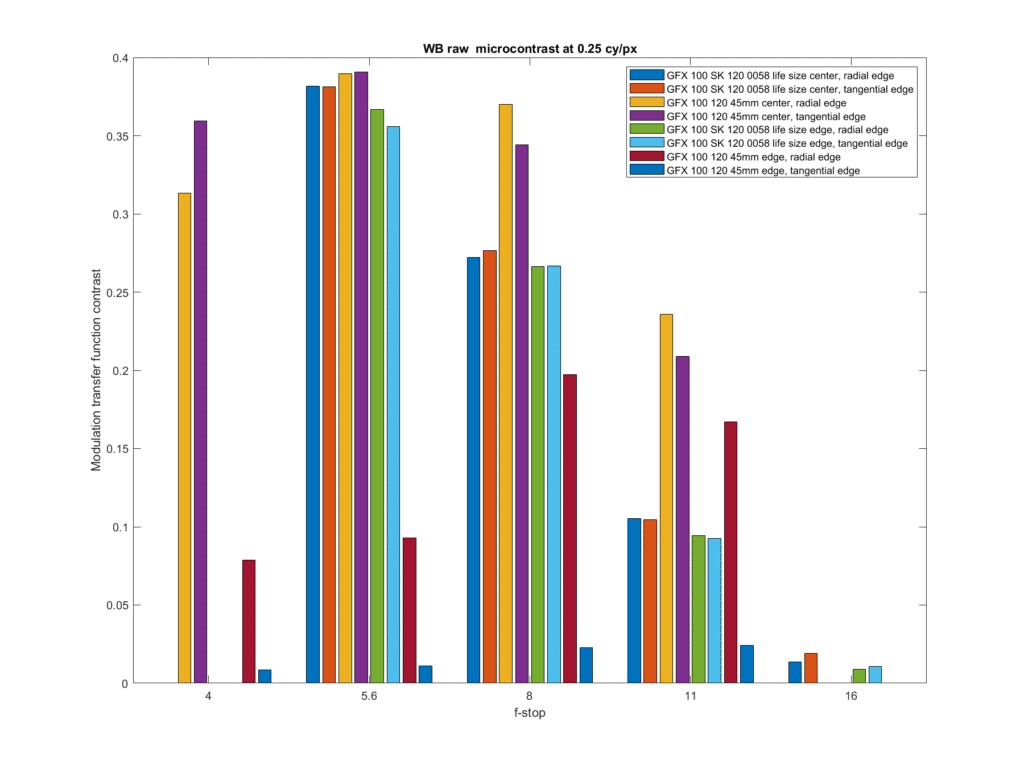
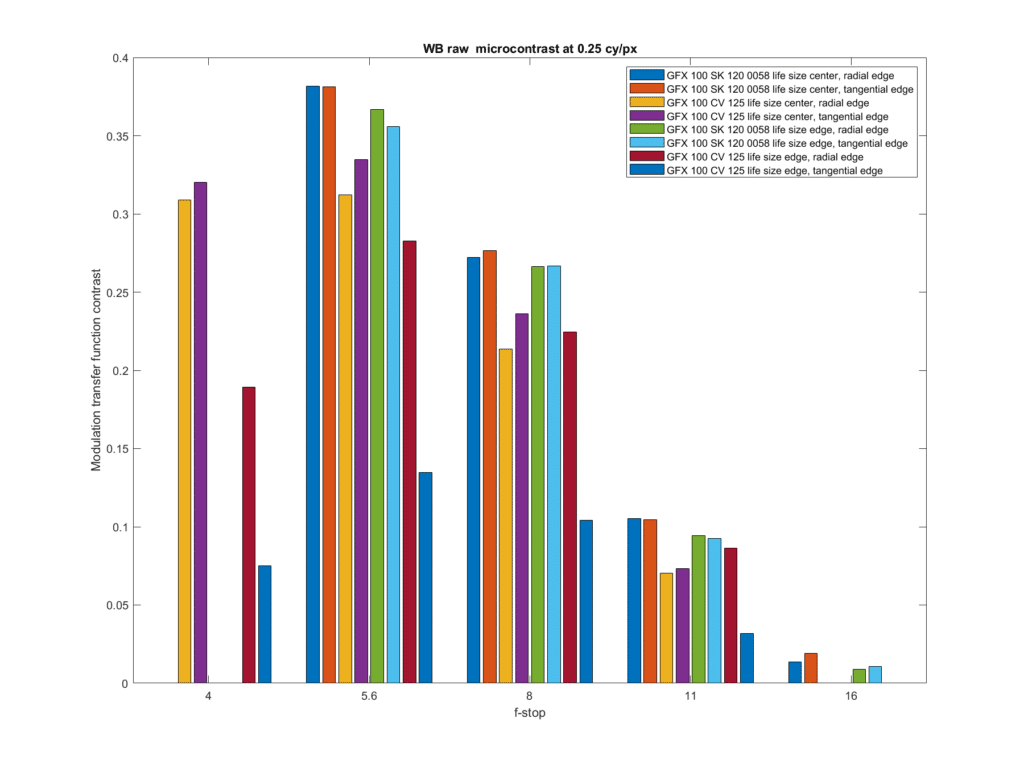
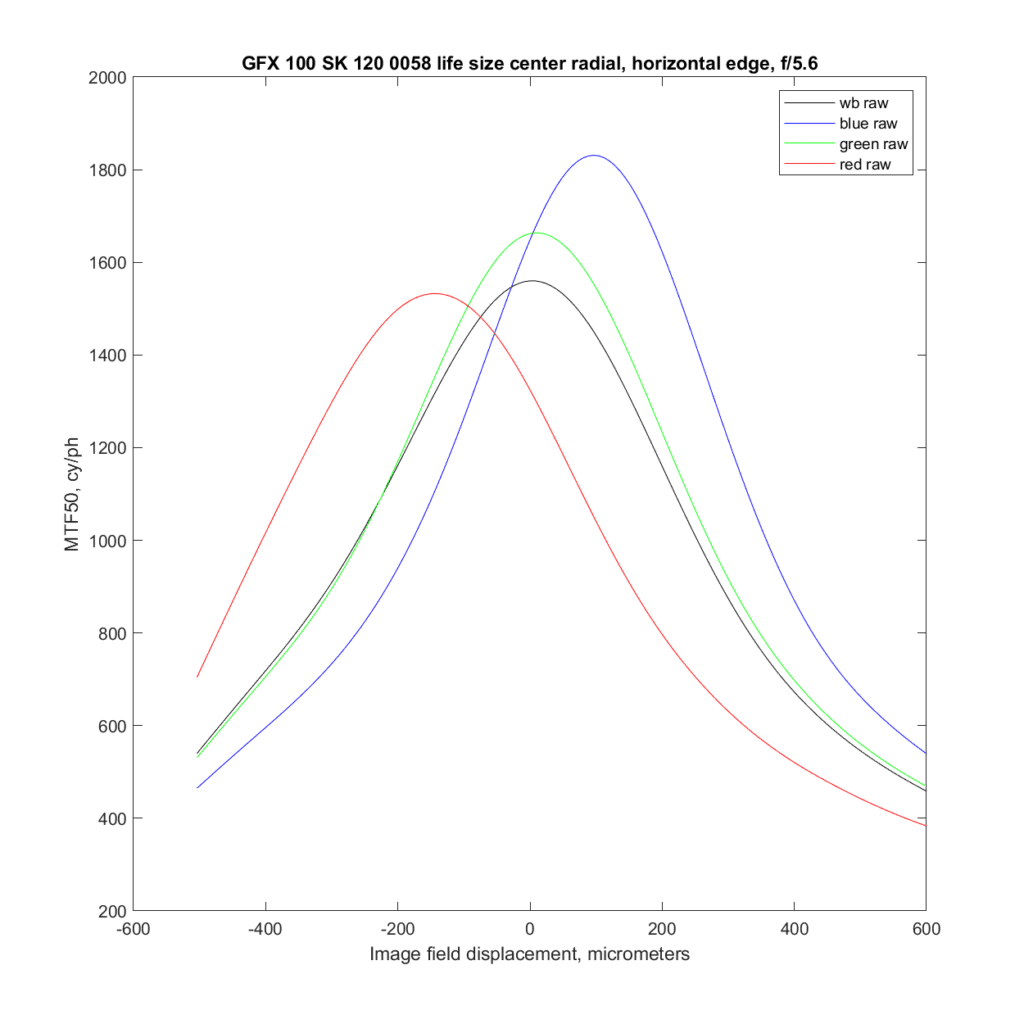

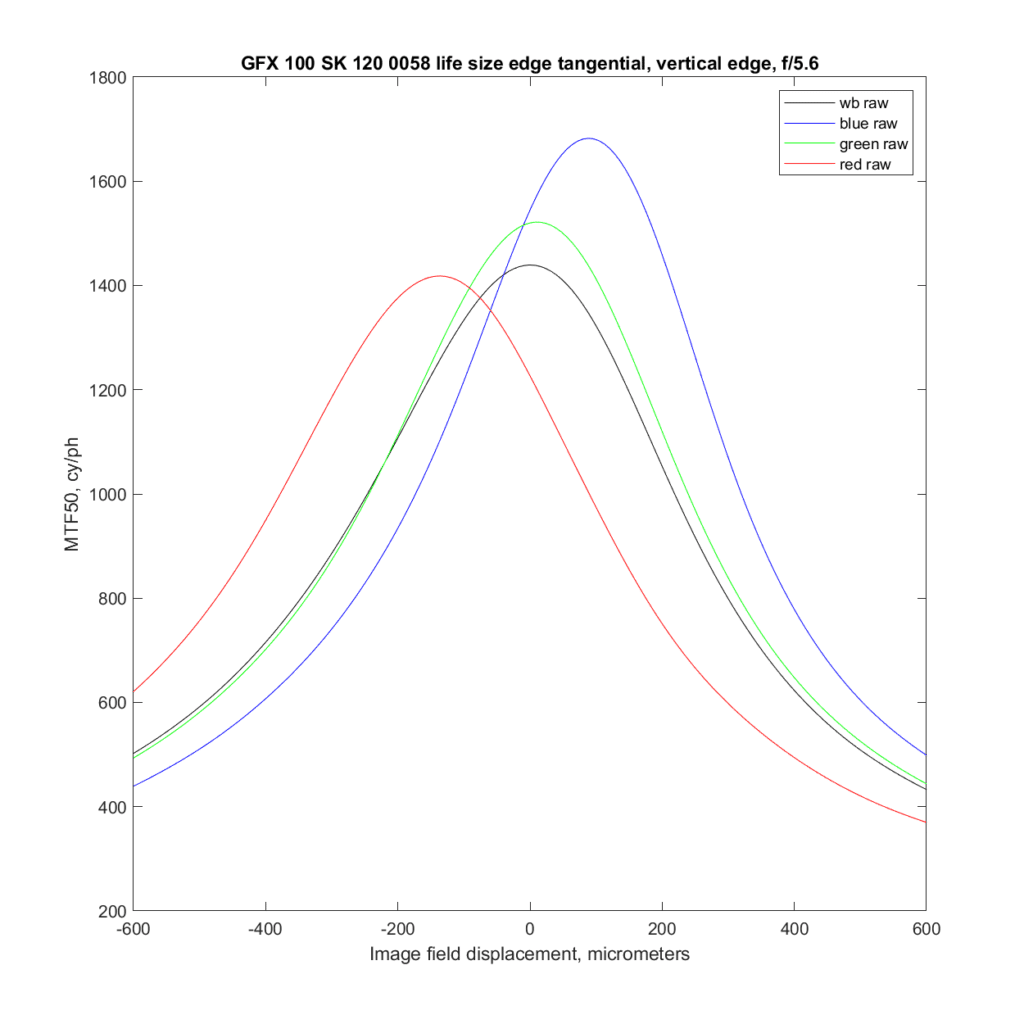
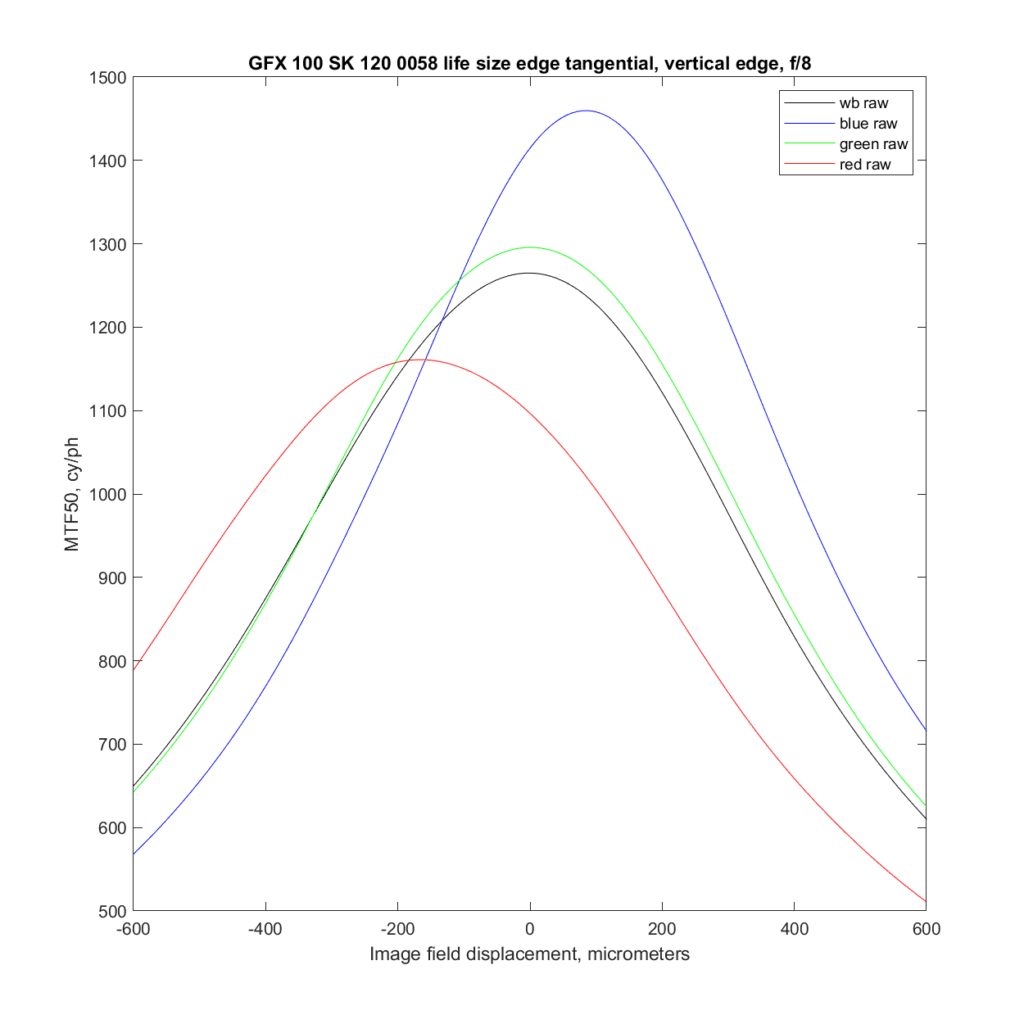
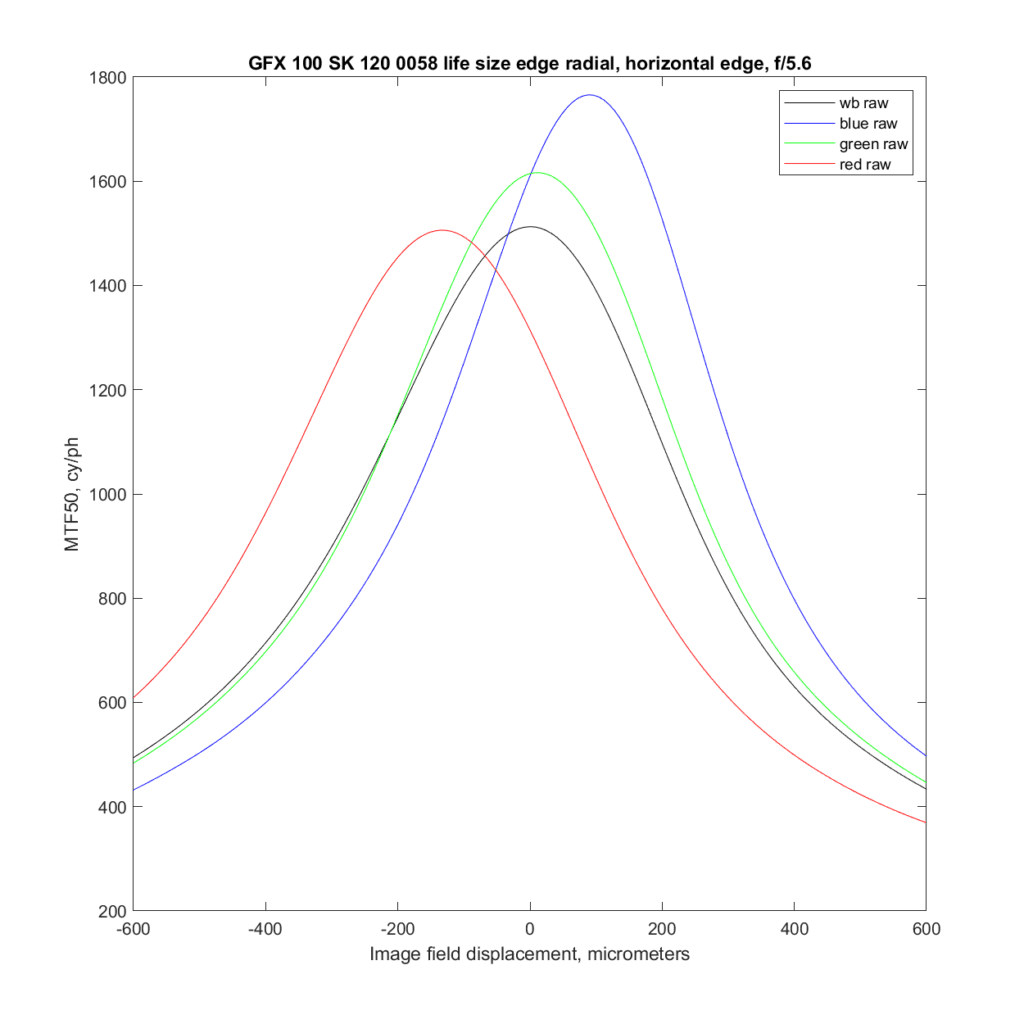
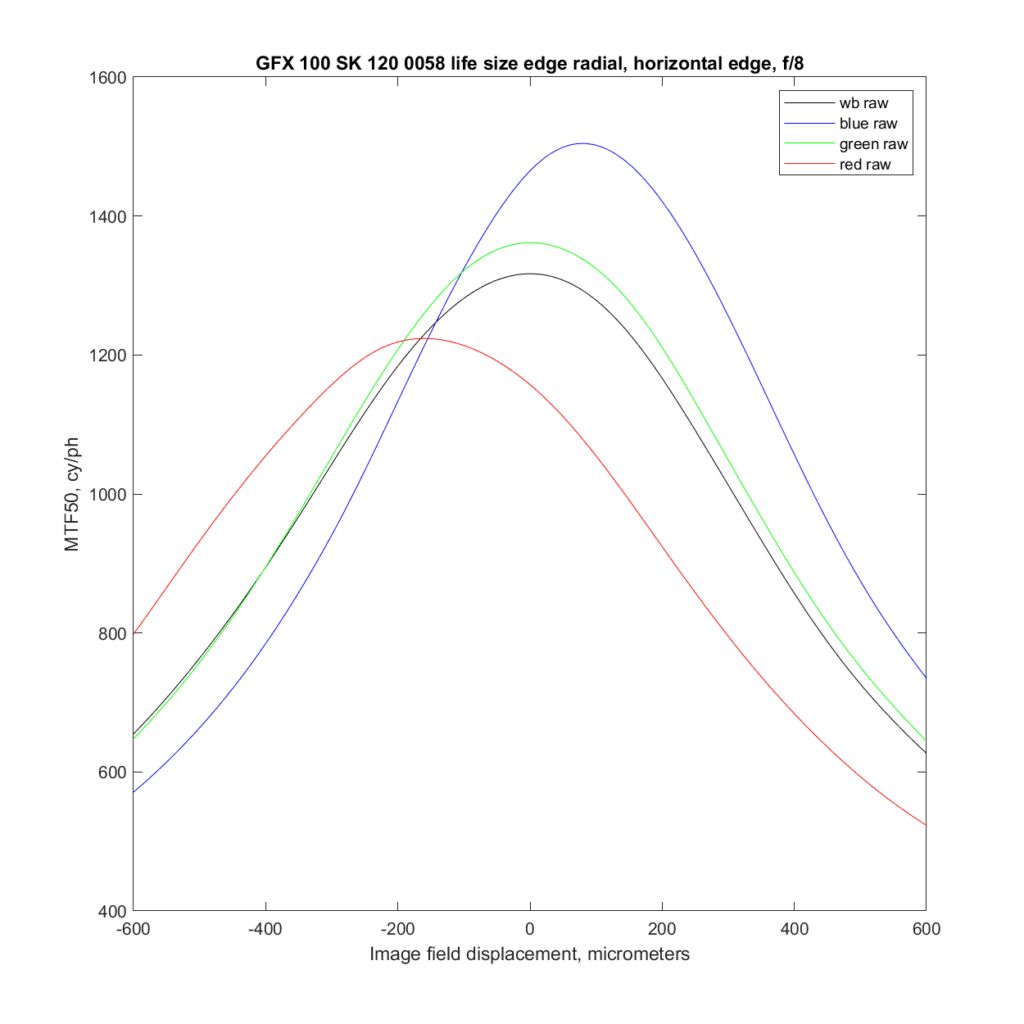
The Schneider Makro-Symmar HM series was sold in shutter for view cameras. This was an eight-element design marketed as a “high-performance repro lens for an approximate 1:1 scale”, with focal lengths 80mm and 120mm offered in #0 shutter and 180mm in #1 shutter.
I wonder whether your 0058 is the same glass as the 120 HM.
Could be…
Thanks!
BTW, if you plan to stack the focus anyway, would not it help to stack R/G/B channels separately?
That’s an interesting thought.
https://www.closeuphotography.com/schneider-apo-digitar-120/2020/1/14/45h9yzp1d6jblwvnf2uthhs9g3s53v
Is this the same lens you tested. I have it in a Copal 0 shutter?
It appears similar. As far as I can tell, the author wasn’t clear about which version of the Makro Symmar he tested.
Here you can see he used version 59 of the regular Macro-Symmar: https://www.closeuphotography.com/schneider-makro-symmar-sr-120
He has also used Macro-Symmar HM. https://www.closeuphotography.com/schneider-makro-symmar-120mm
Hi Jim.
Thanks for posting that information!
I bought one of these lenses second hand recently to put on my gfx with an old mamiya bellows system.
I was shooting with a medium sized aperture thinking that would give the best results, but turned out a bit soft.
After looking at your charts decided to shoot with a more open aperture and it’s much better!
If I’m ready your charts correctly, I’m best to stick to f5.6 for maximum sharpness?
On my lens it has the numbers 1-6, with 1 being the widest. I’ve been shooting at 2.5 and getting good results.
What number would be the equivalent of f5.6?
Cheers,
Ian
1, I would think.
Hi Jim, where did you buy your Makro-Symmar? There are many similar Chinese listings across platforms. They’re the only immediate option for some variants, but I’m unsure of the risk.
I bought one from a friend, and two on eBay. I don’t remember the sellers.
Trying to get the same setup myself. How long is the total length of your extension tubes?
Thanks!
I use a tech camera. About 250 mm bellows draw for 1:1.